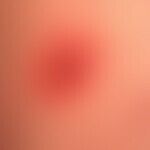Synonym(s)
HistoryThis section has been translated automatically.
Ferdinand v. Hebra first described erythema exsudativum multiforme in his textbook in 1860 as a purely cutaneous, polymorphic erythema (exanthema) with a benign course. In 1876, clinically more severe, similar cases were described with skin and mucous membrane involvement. In 1922, the syndrome described by Stevens and Johnson, a febrile exanthema with stomatitis and purulent conjunctivitis, was published. In 1956, the term toxic epidermal necrolysis was created by Lyell (Lyell syndrome). Recently, there has been a tendency to combine Stevens-Johnson syndrome and toxic epidermal necrolysis under the generic term EN - epidermal necrolysis.
DefinitionThis section has been translated automatically.
Erythema multiforme is a polyetiologic, mucocutaneous inflammatory syndrome triggered by an infection-induced hyperergic immune reaction. Clinically, EM is characterized by an acute to subacute, self-limited exanthema prone to recurrence with characteristic, well-defined, targetoid (disc-in-disc structure with heterogeneous ring formations, possibly also central blistering) and localized blistering. (disc-in-disc structure with heterogeneous ring formations, possibly also central blistering) as well as localized but also confluent plaques, maximum 1.0-3.0 cm in size (so-called typical cockades), and possible mucosal involvement (oral mucosa, conjunctiva, genital and anal mucosa). The classic erythema multiforme (EM minor variant) is usually mild and is mainly caused by herpes simplex viruses but also other viruses and bacteria (e.g. mycoplasma). Involvement of the lips/mouth mucosa can be detected in 20-70% of patients. A few patients suffer a recurrent form with recurring attacks over months and years.
You might also be interested in
ClassificationThis section has been translated automatically.
The following variants can be distinguished on the basis of different clinical forms:
- Erythema (exsudativum) multiforme minor: mild (classic) form, which is mainly triggered by herpes simplex infections. Involvement of the lip and oral mucosa is observed in 20-70% of cases. Some cases recur. A recurrent course over many years is possible (recurrent erythema multiforme)
- Erythema (exudativum) multiforme major: Erythema multiforme major is much more severe with skin and varying degrees of mucosal involvement (conjunctiva, labial and oral mucosa, anal and genital mucosa). In addition to the typical cockades (iris lesions), the major form also has "atypical bi-zonal cockades" (atypical cockades) with a mostly blistered or erosive center. This variant must be differentiated from SJS and TEN. In adults, the cause is the herpes simplex virus (HSV), in children and adolescents a high percentage of mycoplasmas (Mycoplasma pneumoniae) (see also RIMEand MIRM). In the major form, skin exfoliations are <10% in contrast to SJS (<10% of KOF)
- Fuchs syndrome: Clinical variant of erythema multiforme major with exclusive involvement of the conjunctiva and oral mucosa (name no longer in use today).
- Ectodermosis erosiva pluriorificialis (Rendu-Fiessinger): Clinical variant of erythema multiforme major with involvement of the oral, genital and anal mucosa (term no longer in use today).
- S.a. Reactive infectious mucocutaneous eruption (RIME)
- S.a. Mycoplasma-induced rash and mucositis (MIRM ), an inflammatory mucocutaneous eruption associated with infections caused by Mycoplasma pneumoniae. Other associated pathogens that cause this inflammatory symptomatology have since been identified. The name RIME is preferred.
In principle, EM should be distinguished from epidermal necrolysis (EN), an epidermolytic disease entity that combines the two previously separate clinical pictures - Stevens-Johnson syndrome / toxic epidermal necrolysis - under the diagnosis of EN.
Occurrence/EpidemiologyThis section has been translated automatically.
Predominantly occurring in young adults (2nd-4th decade of life), also occurring in children, mostly after mycoplasma infections (see Mycoplasma pneumoniae below) m:w=1:1; no known ethnic prevalence.
EtiopathogenesisThis section has been translated automatically.
Genetics: There is evidence of a genetic predisposition to EEM with the following HLA associations: HLA-DQw3, DRw53, AW33. HLA associations play an increasingly minor role in current pathogenetic considerations.
Infections: In the majority of adolescents and adults, herpes simplex type 1 (HSV-1) infections precede the exanthema or appear clinically after the onset of the exanthema. Using molecular biological methods, HSV-DNA could be detected in lesional skin. It can be assumed that herpes antigens expressed by keratinocytes (this may also apply to other microbial antigens) lead to a CD8+, cytotoxic immune reaction and keratinocyte apoptosis (satellite cell necrosis). The historical interpretation as "immune complex vasculitis" is outdated.
Associations with other infectious diseases such as HSV type II (HSV-2), varicella, parapoxviruses(Orf virus), parvovirus B19, hepatitis C, SARS-CoV-2 (Thielmann CM et al. 2022), Histoplasma capsulatum, EBV infections, streptococci or mycoplasma (mycoplasma infections occur more frequently in children - see below). Mycoplasma pneumoniae - see also RIME) have been reported.
More rarely, EM has been associated with severe mycotic or Gardnerella vaginalis infections.
EEM and SARS-CoV-2: In a cross-sectional analysis (n= 43,547 patients with a history of SARS-CoV-2 infection), the risk of EM was 6.68 times higher than in patients without COVID-19 (Saleh W et al. 2024).
Vaccinations: Vaccinations (mumps-rubella vaccinations, hepatitis B vaccinations, vaccinations with the polyvalent HPV vaccine) often precede erythema multiforme. At 2.7, the risk of developing EM after a SARS-CoV-2 vaccination is significantly higher than in the general population. The prevalence of EM after SARS-CoV-2 infection or vaccination differs significantly from that of the general population (Saleh W et al. 2024).
ManifestationThis section has been translated automatically.
Occurs mainly in young adults, low androtrophy. Frequency peak: 20 - 40 LJ. Rarely in infants.
LocalizationThis section has been translated automatically.
EM minoravriante: back of the hands, palms and soles of the feet, neck, face and neck, extensor sides of the upper extremity; grouped in the elbow area, more rarely the knee. The trunk can also be affected (see Fig.).
Mild (mostly oral) mucosal involvement (lips, buccal mucosa and tongue / erythema multiforme - minor form ) in about 50% of cases.
Erythema multiforme-majus: extremity on the extensor side, in children often trunk-emphasized.
ClinicThis section has been translated automatically.
Minor-type EM occurs with non-sepcific prodromes with malaise, flu-like symptoms and mild to moderate fever. The exanthema develops rapidly and in episodes within 48-72 hours. It is characterized by a disseminated, usually symmetrical, asymptomatic or slightly burning to itchy exanthema that may also occur in groups in the elbow or knee area. This begins first on the face and the extensor extremities, including the acra.
Initially there are reddish papules 0.1-0.3 cm in size, which expand within 24 hours to form plaques 3-4 cm in size, which are well demarcated from the healthy skin. Their color is reddish-livid, rarely also hemorrhagic. The center can sink in, show a tendency to regress with fading, but can also develop in the opposite direction - with intensification, purple components or blistering. Through spurts of activity, which in turn emanate from the center, concentric rings develop in a wave-like manner (shooting target phenomenon - cockade lesions). The cocard lesions usually remain single, but can also merge to form 8-formations or polycyclic formations. Their size remains limited, even in the case of confluence of 2 or more lesions, by a tendency to heal after 10-21 days. Linear formations are possible. A Köbner phenomenon is rarely detectable.
The EM lesions of the minor type do not form necroses and heal without scarring. Lymphadenitis may occur if the oral mucosa is affected. There is no infestation of internal organs.
HistologyThis section has been translated automatically.
The histologic picture corresponds to that of classic acute cytotoxic interface dermatitis.
To be distinguished are:
- Early stage: Basket-weave orthokeratotic stratum corneum, edema of the papillary body with sparse lymphocytic infiltrate, scattered eosinophilic granulocytes, marked exocytosis with condensation of lymphocytes in the lower epithelial layers. Few dyskeratotic keratinocytes (amorphous eosinophilic cytoplasm with pyknotic condensed nuclei). Marked hydropic degeneration of the lower epithelial cell layers.
- Later stage: Basket-weave orthokeratotic stratum corneum, marked intra- and subepidermal edema to subepithelial blistering; vacuolar degeneration of epidermis. Vigorous lymphocytic infiltrate with variable admixture of eosinophilic granulocytes. Numerous dyskeratotic keratinocytes, which may also be aggregated into nests.
Differential diagnosisThis section has been translated automatically.
- Clinical:
- Acute febrile neutrophilic dermatosis(Sweet syndrome): Clinically and morphologically similar in the early phase of the disease. However, the typical cocardia (iris lesions) are absent in Sweet's syndrome. Always fever, severe feeling of illness and neutrophilic leukocytosis.
- Polymorphic light dermatosis: Occurs after UV exposure (sun pattern!); severe itching, never involving the mucous membranes.
- Hand-foot-mouth disease: Endemic occurrence, febrile prodromes, oral mucosa: initially pinhead-sized intraoral erythema which rapidly transforms into translucent vesicles; later yellowish-white, very painful aphthae. Painful, vesicular exanthema on hands and feet, especially on palmae and plantae, with intermittent, disseminated, flat, angular papules which transform into elongated, polygonal vesicles with a reddened halo, and later into pustules.
- Acute urticaria: Clinical determination of wheals (prove volatility by marking). No erythema multiforme cocardia.
- Urticarial vasculitis: markedly intermittent chronicity. Small-spotted, maculo-papular, itchy or painful exanthema accompanied by fever attacks. Neutrophilic leukocytosis is possible. Frequent arthralgias and arthritides; no erythema exsudativum multiforme cocardia. Swelling of lymph nodes. Possibly positive ANA and signs of systemic lupus erythematosus. Histologically, signs of vasculitis are diagnostic. They are always absent in EM.
- Subacute cutaneous lupus erythematosus: A picture similar to erythema exsudativum multiforme may develop(Rowell syndrome), particularly in the case of a highly acute course with disseminated plaques. Histology and immunohistology are diagnostic.
- Drug exanthema (maculo-papular): No real DD, as erythema exsudativum multiforme can be triggered by drugs. A maculo-papular drug erythema can be diagnosed if a connection with altered or intercurrent drug administration can be established.
- Bullous pemphigoid: In some cases, especially in the initial phase of bullous pemphigoid, the pioneering blisters may be absent. This eliminates the leading clinical symptom of "bulging (firm) blisters" and the clear clinical classification as a blistering disease. Histology and IF are conclusive.
- Stevens-Johnson syndrome: Initial febrile, catarrhal prodromal symptoms, generalized lymphadenopathy, liver and spleen involvement. Always mucosal manifestations. Skin manifestations of varying extent: from a few atypical cockades with a maximum of two zones to an extensive, scarlatiniform exanthema. Stevens-Johnson syndrome, in contrast to EEM, shows no(!) shooting-disk-like efflorescences, but rather trunk-emphasized, so-called "atypical cockades" with a maximum of two zones. In addition, unlike erythema multiforme, it can develop into toxic epidermal necrolysis(TEN).
- RIME/MIRM differs from herpes-associated erythema multiforme in its predominant mucosal involvement, relatively sparse skin findings, prevalence in younger patients and excellent prognosis. There is a clear association with Mycoplasma pneumoniae infections.
- Histologically
: Note! There are smooth transitions between erythema exsudativum multiforme, Stevens-Johnson syndrome and toxic epidermal necrolysis. Histologically, all diseases with (occasional) subepidermal blistering must be considered ( dermatitis solaris, graft-versus-host disease, ictus, lichen planus bullosus, lichen sclerosus et atrophícus, polymorphic light dermatosis, systemic amyloidosis, porphyria cutanea tarda).
- Toxic epidermal necrolysis (TEN ): Subepidermal blister, broad necrosis of the entire epidermis, pronounced dermal edema. Only slight, diffuse lymphocyte infiltration; erythrocyte extravasations.
- Staphylococcal scalded skin syndrome (SSSS): As previously with TEN; blistering but subcorneal.
- Drug reaction, fixed: Interface dermatitis with numerous apoptotic keratinocytes, lichenoid and perivascular inflammatory reaction of the upper and middle (usually also the deep) dermis; usually pronounced pigment incontinence.
- Graft-versus-host disease, acute: Apoptotic keratinocytes, possibly subepithelial blistering, lichenoid infiltrate, eosinophilic granulocytes.
- Urticaria: Only slight infiltrate; no apoptotic keratinocytes.
- Pityriasis lichenoides et varioliformis acuta: Interface dermatitis with irregular acanthosis, two-layered structure of the str. corneum with basket-weave-like orthokeratosis over a continuous parakeratosis zone. In the dermis rather wedge-shaped, perivascular or interstitial infiltrate of lymphocytes.
- Erythema elevatum diutinum: Rare disease! In the early stage always signs of leukocytoclastic vasculitis with leukocytoclasia and nuclear dust as well as fibrin in the vessel walls. Epidermis and skin appendages remain unaffected.
TherapyThis section has been translated automatically.
It is an acute, self-liminating disease. In this respect, symptomatic therapy is generally sufficient.
External therapyThis section has been translated automatically.
Local treatment with Lotio alba is usually sufficient. For more severe itching and pronounced skin infestation, medium-strength glucocorticoid-containing externals such as 0.1% triamcinolone cream (e.g., Triamgalen, Delphicort,Triamcinolone acetonide cream hydrophilic 0.025/0.05/0.1% (NRF 11.38.), or 0.05-1% betamethasone emulsion (e.g., Betagalen®, Betnesol, betamethasone valerate emulsion hydrophilic 0.025/0.05 or 0.1% (NRF 11.47.) are indicated. If the oral mucosa is affected, mouth rinses with antiphlogistic preparations (e.g., chamomile extracts).
Internal therapyThis section has been translated automatically.
If symptoms are pronounced, systemic glucocorticoids such as prednisone (e.g. Decortin Tbl.) 50-75 mg/day. Additionally, in case of itching, antihistamines, e.g. desloratadine (Aerius), levocetirizine (Xyzall), cetirizine (Zyrtec) p.o. In case of frequent (postherpetic) recurrences, oral prophylaxis with aciclovir for 1 year is indicated (10 mg/kg bw/day) (evidence level: IB).
Progression/forecastThis section has been translated automatically.
Favorable. Self-limiting course with complete healing after 10 to 14 days.
EM-recidivans: Recurrent course is possible, with irregular occurrence of usually 1-2 recurrences/year, less frequently (up to 10 recurrences/year). In recurrent EM, the episodes are preceded in 20% to >80% by a herpes simplex infection (herpes labialis/genital herpes) (post-herpetic EM).
Prolonged lesional hyperpigmentation is possible.
More frequent episodes are observed in immunosuppressed patients.
Some patients recur seasonally, e.g. once a year in spring.
Note(s)This section has been translated automatically.
Depending on the expressivity, severity and localization of the skin and/or mucous membrane lesions, different names have been used in the past for erythema multiforme. The terms that are internationally accepted as entities are printed in bold:
- erythema exsudativum multiforme (originally named by v. Hebra)
- erythema multiforme majus
- Erythema multiforme majorform
- Erythema multiforme minor form (originally described form, mild course, predominantly cutaneous infestation. Classic erythema exsudativum multiforme
- Dermatostomatitis Baader
- Stevens-Johnson syndrome (SJS)
- Stevens-Johnson syndrome/TEN (SJS/TEN) overlap syndrome
- Stevens-Johnson-Fuchs syndrome (syndroma muco-cutaneo-oculare Fuchs)
- Erythema multiforme recidivans
- Recurrent EEM
- Fiessinger-Rendu syndrome(ectodermosis érosive pluriorificielle)
- Reactive infectious mucocutaneous eruption(RIME)
LiteratureThis section has been translated automatically.
- Ayangco L et al. (2003) Oral manifestations of erythema multiforme. Dermatol Clin 21: 195-205
- Das S et al. (2000) Herpes simplex virus type 1 as a cause of widespread intracorneal blistering of the lower limbs. Clin Exp Dermatol 25: 119-121.
- Grünwald P et al. (2020) Erythema multiforme, Stevens-Johnson syndrome/toxic epidermal necrolysis - diagnosis and treatment. J Dtsch Dermatol Ges 18:547-553.
- Hidajat C et al (2014) Drug-mediated rash: erythema multiforme versus Stevens-Johnson syndrome. BMJ Case Rep 22 PubMed PMID: 25246464.
- Johnston GA et al (2002) Neonatal erythema multiforme major. Clin Exp Dermatol 27: 661-664
- Labé P et al (2020) Erythema multiforme and Kawasaki disease associated with COVID-19 infection in children. J Eur Acad Dermatol Venereol 34:e539-e541
- Lavery MJ et al. (2021) A flare of pre-existing erythema multiforme following BNT162b2 (Pfizer-BioNTech) COVID-19 vaccine. Clin Exp Dermatol 46:1325-7.
- Molnar I, Matulis M. (2002) Arthritis associated with recurrent erythema multiforme responding to oral acyclovir. Clin Rheumatol 21: 415-417
- Saleh W et al. (2024) Increased prevalence of erythema multiforme in patients with COVID-19 infection or vaccination. Sci Rep 14:2801.
- Samim F et al.(2013) Erythema multiforme: a review of epidemiology, pathogenesis, clinical features, and treatment. Dent Clin North Am 57:583-96.
- Seishima M, Oyama Z, Yamamura M (2001) Erythema multiforme associated with cytomegalovirus infection in nonimmunosuppressed patients. Dermatology 203: 299-302
- Sun J et al. (2014) Stevens-Johnson syndrome and toxic epidermal necrolysis: a multi-aspect comparative 7-year study from the People's Republic of China. Drug Des Devel Ther 8:2539-1547
- Tatnall FM et al. (1995) A double-blind, placebo-controlled trial of continuous acyclovir therapy in recurrent erythema multiforme. Br J Dermatol 132: 267-270
- Thielmann CM et al (2022) COVID-19-Triggered EEM-Like Skin Lesions. Dtsch Arztebl Int 119:131.
- Trayes KP et al. (2019) Erythema Multiforme: Recognition and Management. Am Fam Physician. 100: 82-88.
- von Hebra F, Kaposi M (1860) Acute exanthema and skin diseases. Textbook of skin diseases. Volume 1, Enke, Erlangen
- von Hebra, FR (1867). Erythema Exsudativum Multiforme (Hebra), in: Atlas der Hautkrankheiten. Published by Ferdinand Enke, pp 3-4.
- Wang S et al. (2022) 5-Fluorouracil and actinomycin D lead to erythema multiforme drug eruption in chemotherapy of invasive mole: Case report and literature review. Medicine (Baltimore) 101:e31678
Incoming links (101)
Abacavir; Acute Hemorrhagic Edema of Infancy ; ; Acute Syndrome of Apoptotic Panepidermolysis; Amprenavir; Anonychie acquired; Antibiotic allergy; Aphthosis neumann; Azithromycin; Baader, dermatostomatitis; Balanitis symptomatica; ... Show allOutgoing links (48)
Aciclovir; Amyloidosis systemic (overview); Antihistamines; Betamethasone valerate emulsion hydrophilic 0,025/0,05 or 0,1 % (nrf 11.47.); Bullous Pemphigoid ; Cetirizine; Contagious ecthyma; Desloratadine; Drug exanthema maculo-papular; Epidermal nekrolysis; ... Show allDisclaimer
Please ask your physician for a reliable diagnosis. This website is only meant as a reference.








































































